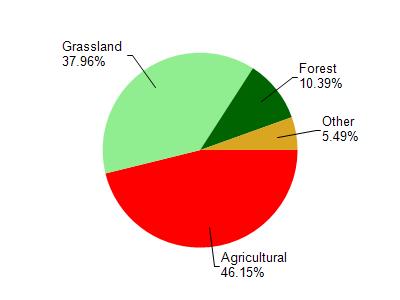Grant
No
No
No
Fish and Aquatic Life
Overview
This four mile long moderate gradient stream was formerly on the state’s 303(d) list, but was removed in 2002 due to lack of supporting data. Indeed, there is very little data for this stream. The 2009 survey of the lower section of stream showed a fair assemblage of coolwater transitional forage species, typical of the rock, rubble/cobble streams in this area. The stream fl ows through a heavily wooded corridor for most of its length with some row cropping at its headwaters. Filamentous algae on the rocks was quite prevalent and indicative of nutrient loading from nonpoint source pollution.
Date 2011
Author James Amrhein
Historical Description
A moderate-gradient, spring-fed stream entering the Little Platte River from the north three miles southwest of Platteville. Nearly 90 percent of the land in the watershed has been cleared for agricultural purposes. This factor along with overgrazing in many sections, has resulted in heavy bank erosion. Very few pools exist and the water remains stained during much of the year due to the many pig yards near the headwaters. These adverse conditions make this stream suitable only for forage species. A cheese factory located along Highway B is considered a potential source of pollution. Game assets are limited to raccoon, squirrels, deer, and ruffed grouse. The stream is accessible through private lands with permission and from the Little Platte River.
From: Smith, Tom D., and Ball, Joseph R., Lake and Stream Classification Project. Surface Water Resources of Grant County, Department of Natural Resources, 1972. Surface Area = 1.15 acres, Length = 1.9 miles, Gradient = 63 ft./mile, Flow = 0.6 c.f.s.
Date
Author Aquatic Biologist
Condition
Wisconsin has over 84,000 miles of streams, 15,000 lakes and milllions of acres of wetlands. Assessing the condition of this vast amount of water is challenging. The state's water monitoring program uses a media-based, cross-program approach to analyze water condition. An updated monitoring strategy (2015-2020) is now available. Compliance with Clean Water Act fishable, swimmable standards are located in the Executive Summary of Water Condition in 2018. See also the 'monitoring and projects' tab.
Reports
Management Goals
Wisconsin's Water Quality Standards provide qualitative and quantitative goals for waters that are protective of Fishable, Swimmable conditions [Learn more]. Waters that do not meet water quality standards are considered impaired and restoration actions are planned and carried out until the water is once again fishable and swimmable
Management goals can include creation or implementation of a Total Maximum Daily Load analysis, a Nine Key Element Plan, or other restoration work, education and outreach and more. If specific recommendations exist for this water, they will be displayed below online.
Monitoring
Monitoring the condition of a river, stream, or lake includes gathering physical, chemical, biological, and habitat data. Comprehensive studies often gather all these parameters in great detail, while lighter assessment events will involve sampling physical, chemical and biological data such as macroinvertebrates. Aquatic macroinvertebrates and fish communities integrate watershed or catchment condition, providing great insight into overall ecosystem health. Chemical and habitat parameters tell researchers more about human induced problems including contaminated runoff, point source dischargers, or habitat issues that foster or limit the potential of aquatic communities to thrive in a given area. Wisconsin's Water Monitoring Strategy was recenty updated.
Grants and Management Projects
| Project Name (Click for Details) | Year Started |
|---|
|
|
Monitoring Projects
| WBIC | Official Waterbody Name | Station ID | Station Name | Earliest Fieldwork Date | Latest Fieldwork Date | View Station | View Data |
|---|
| 945800 | Whig Br | 10030433 | Whig Branch - 70 M upstream of confluence with LIttle Platte River | 11/12/2009 | 1/1/2015 | Map | Data |
|

Watershed Characteristics
Whig Br is located in the Little Platte River watershed which is 154.94 mi². Land use in the watershed is primarily agricultural (46.20%), grassland (38%) and a mix of forest (10.40%) and other uses (5.50%). This watershed has 389.19 stream miles, 19.99 lake acres and 585.06 wetland acres.
Nonpoint Source Characteristics
This watershed is ranked High for runoff impacts on streams, Not Available for runoff impacts on lakes and High for runoff impacts on groundwater and therefore has an overall rank of High. This value can be used in ranking the watershed or individual waterbodies for grant funding under state and county programs.However, all waters are affected by diffuse pollutant sources regardless of initial water quality. Applications for specific runoff projects under state or county grant programs may be pursued. For more information, go to surface water program grants.